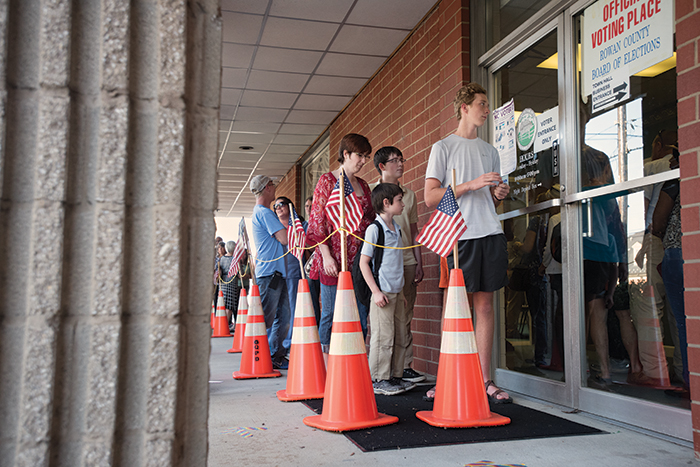Dr. Michael Bitzer: NC voter registration nears 7 million
Published 9:56 pm Sunday, July 15, 2018

- People wait in a long line to cast their primary votes at the Granite Quarry Municipal Building in Salisbury in March.
Now that we’re half-way through 2018, the North Carolina registered voter pool slowly creeps towards 7 million active and inactive voters. As of July 7, 6,962,898 voters were on the roll, an increase of nearly 125,000 since the beginning of the year.
Among the patterns of registration since the beginning of 2018, unaffiliated registrations have been the significant plurality, while Democratic registrations lead Republican registrations. At the end of the first six months of 2018, 45 percent of new voters registered as unaffiliated, with 30 percent Democratic and 24 percent Republican.
Of the 6.9 million voters, the overall party registration percentages breaks down to 38 percent registered Democrats, 31 percent registered unaffiliated and 30 percent registered Republican. The other party registrations — Libertarian, Green and the Constitution parties — are 1 percent.
In looking at a variety of ways of breaking down the state’s voter pool, I break it down by race, generational cohorts, gender, and region (urban, suburban, and rural counties), along with a focus on two congressional districts that may be in play in this year’s mid-term election.
In terms of race, North Carolina’s voter pool continues to diversify, with less than 70 percent of the voters indicating they are white.
With a plurality (41 percent) of white voters registered as Republican, Democratic registration continues to dominate among black/African-American voters (81 percent), while almost a majority (49 percent) of voters of all other races (Asian, Native Indian, multi-racial, other, and unknown/unreported) registered as unaffiliated.
With 32 percent of the nearly 7 million registered North Carolina voters under the age of 37 years old — and thus members of the Millennial (22-37 years old) and Generation Z (18-22 years old) — the rise of the unaffiliated voter can be traced back to the fact that over 40 percent of both generations have registered with neither major party. Since the beginning of 2018, these two generations have dominated the new registrations, with 57 percent of voters in the first six months of the year belonging to either the Gen Z or Millennial cohorts.
With the dramatic rise in unaffiliated registrations among white voters, there is a notable decline in Democratic registration, going from 38 percent among the oldest voters to only 16 percent among the youngest. Republican registration trends shows a considerable break between Generation X and older voters, in low 40s, to the mid-thirties among Millennials and Generation Z voters.
Among black voters, the potential loyalty of Democratic dominance may be waning, especially among younger black voters.
With only two-thirds of Gen Z black voters registering Democratic, this trend towards unaffiliated status may just be an undercurrent, since voting tendencies tends to still be overwhelming Democratic when it comes to black ballots.
Among all other races by generations, the downward trends among registered partisans, with the corresponding unaffiliated rise, is very clear.
For the time being, the congressional districts with the most interest are the 9th and 13th, both currently held by Republicans. In looking at the 9th, the Republican party registration number is at 31 percent, which is the lowest percentage for a Republican-held district in the state. A recently released Civitas Poll shows a significant gender gap between Democrat Dan McCready and Republican Mark Harris, and this gender difference is also evident in the district’s voter registration numbers as well.
The 13th district has an overall GOP percentage of 34, which is the fourth highest percentage of all the districts, but the gender partisan difference is again like the 9th district.
While men in the 13th are more Republican than in the 9th (37 percent to 34 percent, respectively), the Democratic plurality (40 percent) among women is slightly less than in the 9th (42 percent).
North Carolina’s mid-term elections tend to have a higher registered Republican turnout rate than in presidential election years, but with the potential for a Democratic wave, all bets may be off with this fall’s campaign.
Dr. Michael Bitzer is director of the Center for Engaged Learning and Teaching at Catawba College. This article is from his blog, Old North State Politics.

